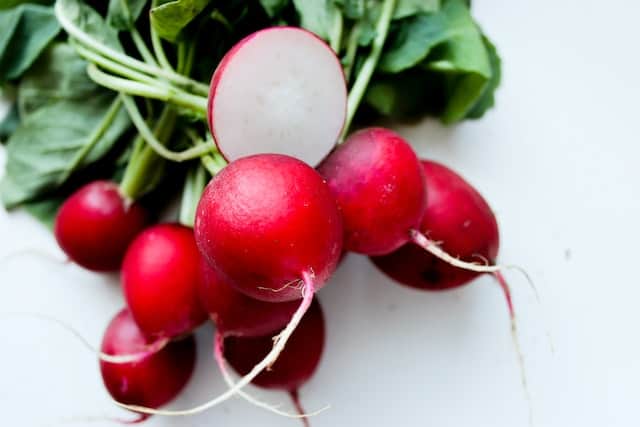How do you classify a food item like radish that seems to check the boxes on most of the important requirements that classify an item as a fruit, root or vegetable?
Well, continue reading to find out how.
Before that, let us briefly go through the definitions of what a fruit is, what a root is, as well as what makes a vegetable a vegetable. That way, we can easily understand why a radish is classified the way it is.

What is a fruit, root and a vegetable?
A food item is classified as a fruit when it develops from the flowering part of a plant. Most fruits contain seeds (though seedless varieties of fruits do exist) from which another plant can germinate and produce new fruits, continuing in this cycle until a dead end is reached in one way or the other.
Moving on to the roots, it is the part of a plant that grows underground. And as for vegetables, it is the edible parts of a plant which could encompass every single part of it, including the fruits.
From these quick definitions, we can observe that all edible fruits and roots are actually vegetables since they come from the parts of a vegetable. Not all vegetables are fruits though, and certainly not vegetables are roots, because not all vegetables are the “matured ovary that bear seeds” or live underground.
It is good to also point out the fact that not all fruits and roots can be eaten. Some roots are just too tough to be chewed and are better purposed for something that doesn’t involve eating them, and at the same time, some fruits are also poisonous too. But the main concern for this article are the edible parts of a plant, so we really don’t have any business with inedible fruits and roots.
Where does radish fall?
Having gone through the definitions of what a vegetable is, what a fruit is, and also what a root is, we can easily deduce that a radish is both a root and vegetable, which gives its popular name of “root vegetable”.
The radish is not a fruit because it does not fulfill the main criteria of items that are classified as fruits, which is that they must come from the flowering parts of a plant.
So a radish is a root vegetable alongside popular members such as carrots, ginger, potato, yam tubers, cassava tubers, taro corms etc.
What are the different types of radishes?
When it comes to the types of radishes, they are aplenty.
Here are some of the most unique and common types of radishes you can find across the globe.
Daikon radish: This is a winter radish that has a mild flavor and is typically white and cylindrical. It is mostly grown in East and South Asia.
Bunny Tail Radish: These are small petite spheres that have a two tone color (red at the top and white underneath), with taproots that are thin and wiry.
Watermelon radish: This radish gets its name from the fact that it looks like a mini watermelon a green exterior with a red interior.
Easter egg: These are small round to oval in shape and come in different varieties that offer different colors from to pink, purple, red and white. They have a peppery flair with sweet undertones that can be made pronounced with cooking.
Plum purple: These come in various hues of violet and are small and oval in shape.
Snow belle: These come in various hues of white. They are moist and very crunchy with a sharp peppery flavor.
Champion: These are large varieties with less sharp taste compared to other varieties of radishes. They bear hues of red.
Red king: The red kind radish has somewhat of a cylindrical shape and is red in color. It is mild, crispy and also juicy.
Black radish: The black radish is a small round to oval root that has a black exterior with a white interior. Some varieties can have a cylindrical shaped root. The black radish is typically spicy and bitter.
What is the nutritional composition of radish?
For the nutritional composition of radish, we can begin with calories.
Radish is pretty low in calorie as it supplies only 16 kcal for every 100 gram serving. So it’s a great addition to a low calorie diet.
When it comes to vitamins, it appears that the most dominant vitamin in a radish is vitamin C, which makes up about 18% of the daily recommended value in a 100g portion.
The amount of vitamin C that remains after cooking a radish depends greatly on the method of cooking.
Radishes that are boiled in water have about 50 to 60% of their vitamin C content leached out into the water whereas those cooked using low liquid mediums have only a little percentage destroyed.
Radishes also have folate, vitamin B6, niacin and pantothenic acid.
When it comes to minerals, it has a high level of potassium, and also has zinc and calcium.
Radishes have a high water content. For a 100 g radish about 95% is made up of water which gives them their characteristic crispiness.
What are the benefits of eating radish?
According to reliable health sources, incorporating radishes appropriately into a diet does have the potential of reducing the risk of diabetes due to the presence of compounds, such as glucosinolate and isothiocyanate which can help monitor the blood sugar levels.
Eating radishes in moderation can also supply the body with a lot of vitamins and minerals, which will all provide their beneficial purposes to the body.
Can radish be eaten raw?
Radish can be consumed raw and that technique is in fact the most popular and common way of eating radish across the globe.
Radishes can be consumed raw by cutting them in half and spreading butter on their flesh and sprinkling with salt. This is a popular way of eating them in France.
They can also be sliced into salads or cut very thinly and used as garnish alongside shredded lettuce.

